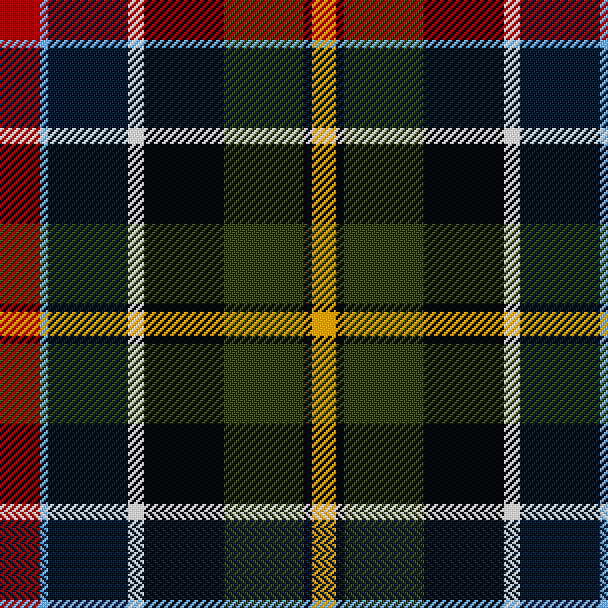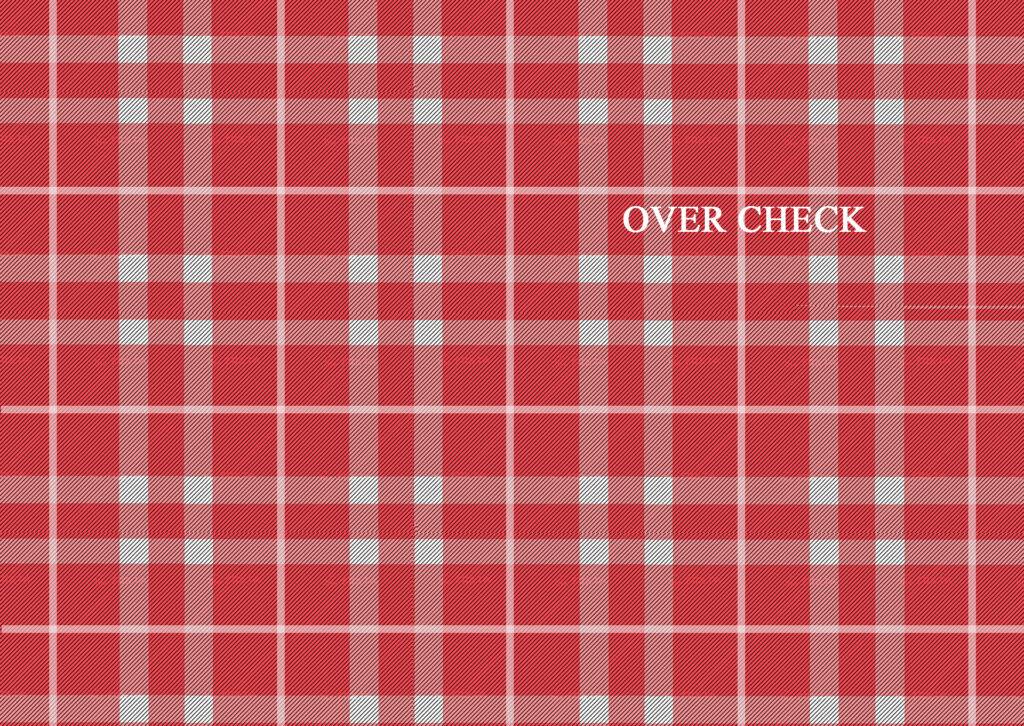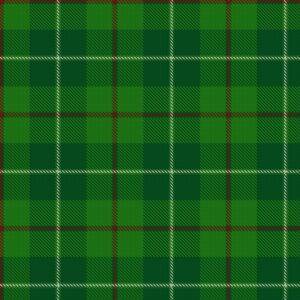
Weaving and Design
January – 2024 30 MINS READ
There isn’t a universally standardized method for writing a thread count, but the various systems are distinguishable. For example:
- The thread count “/K4 R24 K24 Y4/” denotes a mirroring pattern with 4 black, 24 red, 24 black, and 4 yellow threads. The beginning black and ending yellow threads, which are the pivots, are not repeated (after Y4/, colors reverse in order, first K24 then R24); this is considered a “full-count at the pivots” thread count.
- An equivalent way to represent this is by bolding the pivot abbreviations: K4 R24 K24 Y4.
- The same tartan can also be denoted as “K/2 R24 K24 Y/2”, indicating that the initial black and final yellow threads are duplicated before the pattern continues from these pivot points (after Y/2, colors reverse to Y/2, then K24, then R24); this is a “half-count at the pivots” thread count.
- In older and less clear thread-counting methods, without the “/” or bold notation, a count like “K4 R24 K24 Y4” is presumed to be full-count at the pivots unless specified otherwise.
- In all these cases, the result is a half-sett thread count, representing the threading before the pattern mirrors and completes; a full-sett count for a symmetric tartan is redundant. A “/” can also be used between color codes (e.g., “W/Y24” for “white/yellow 24”) for a more concise count in simple tartans that differ only in a color swap in half of the half-sett pattern; however, this is less common.
For an asymmetric tartan, which does not mirror, a full-sett count is represented with “…” markup, like “…K4 R24 K24 Y4…” (after Y4, the pattern starts anew from K4).
Different writers and databases use various color names and abbreviations, so a thread count might not be universally understood without a color key/legend. Some recorders begin the thread count at the pivot with the first color in alphabetical order, but this is arbitrary.
Thread counts, while specific, can be modified for the desired tartan size. For instance, a tartan’s sett might be too large for a necktie, so the thread count is proportionally reduced. In some cases, the count is minimized to the smallest even number needed to accurately replicate the design, which may then be upscaled for kilts and plaids.
Before the 19th century, the weft thread was often up to 1/3 thicker than the warp thread, resulting in a rectangular pattern. The solution was adjusting the weft thread count to square the pattern or intentionally keeping it non-square, as in some traditional tartans. Uneven warp-and-weft thickness could also give a striped look to some tartans.
The dominant colors, or the widest bands, in a tartan are called the under-check, with other terms like ground or background used if there’s one main color. Thin contrasting lines are the over-check, and paired over-checks are sometimes called tram lines. Bright over-checks might be bordered by thin lines, often black, called guard lines. Historically, William Wilson & Son sometimes wove bright over-checks in silk for added shine. Tartan for plaids often features a purled fringe.
糸数を記述する方法には統一された標準がありませんが、異なるシステムは区別しやすいです。例えば:
- 糸数 “/K4 R24 K24 Y4/” は、4つの黒糸、24つの赤糸、24つの黒糸、4つの黄糸の鏡面パターンを表しています。最初の黒と最後の黄色の糸(ピボット)は繰り返されず(Y4/の後、色はK24からR24へと逆になる)、これは「ピボットでのフルカウント」糸数とされます。
- 同じ表記をピボットの略称を太字にすることで表すこともできます:K4 R24 K24 Y4。
- 同じタータンは “K/2 R24 K24 Y/2” としても表され、黒い開始糸と黄色い終了糸がピボットポイントから続くパターンの前に複製されることを示します(Y/2の後、色はY/2に戻り、次にK24、R24になる)。これは「ピボットでのハーフカウント」糸数です。
- 古くて曖昧な糸数カウントのスタイルでは、”/”や太字の表記がない場合、”K4 R24 K24 Y4″のような糸数は、指定がない限り、ピボットでのフルカウントとされます。
- これらの場合、結果はハーフセット糸数となり、パターンが鏡面反射して完成する前の糸通しを表します。対称的なタータンのフルセット糸数は冗長です。”/”は単純なタータンでハーフセットパターンの半分が色交換のみで異なる場合に、より簡潔な糸数を作成するために2つの色コードの間に使用されることもあります(例:”W/Y24″ は “白/黄色 24″)が、これは一般的な糸数カウントのスタイルではありません。
鏡面反射しない非対称タータンは、”…”マークアップを使ってフルセット糸数として表されます。例:”…K4 R24 K24 Y4…”(Y4の後、パターンはK4から再開します)。
さまざまな作家やタータンデータベースは、色名や略語を一貫して使用していないため、色キー/凡例なしでは糸数が普遍的に理解されない可能性があります。一部の記録者は、アルファベット順に最初に来る色名(または略語)でピボットでの糸数を開始することを好む場合がありますが、これは任意のものです。
糸数はかなり具体的ですが、タータンの望ましいサイズに応じて変更することができます。たとえば、タータンのセット(例えば、キルトに典型的なサイズである6インチ四方)がネクタイの表面に収まらない場合、糸数は比例して減少されます(例えば、一辺に3インチ)。場合によっては、デザインを正確に再現するために必要な最小限の偶数の糸数(多くの場合2まで)に糸数を減らすことがあり、このような場合、キルトやプレードでの典型的な使用のために比例して糸数をアップスケールする必要があります。
19世紀以前には、経糸に使用される細い糸と比較して、緯糸の糸が最大1/3太いことがあり、結果として長方形のパターンが生じました。解決策は、緯糸の糸数を調整してパターンを正方形に戻すか、故意に非正方形にすることでした。これはいくつかの伝統的なタータンで今でも行われています。経糸と緯糸の厚さが不均一であることも、一部のタータンサンプルで格子状ではなく縞模様の外観に寄与することがあります。
タータンの主要な色(最も広い帯)は、アンダーチェックと呼ばれ、地色や背景などの他の用語が使用されることもあります。細い対照的な線はオーバーチェックと呼ばれ、ペアのオーバーチェックは時にトラムラインとも呼ばれます。明るいオーバーチェックはしばしば、特にコントラストを高めるために、両側(通常は両方)に追加の細い線、多くの場合黒、と呼ばれるガードラインに囲まれます。歴史的に、ウィリアム・ウィルソン&サン社は、輝きを加えるために時々シルクで明るいオーバーチェックを織りました。プレード用のタータンはしばしばパーリングのフリンジを特徴とします。
18世紀までの古い時代の慣習では、プレードや時折キルトに、ヘリンボーン織りのセルビッジ(布の端の装飾的な縁)を加えることが一般的でした。このセルビッジは通常1〜3インチ(2.5〜7.6 cm)の幅で、セットの色のパターンに合わせていました。現代の一部の織り手は、この伝統的なスタイルでタータンを製作し続けています。より装飾的なセルビッジも使用されました:これらは、セットの色を広いバンドで繰り返して形成されたボーダー(通常は片側だけ)で、しばしばヘリンボーンで、時にはセットの別の色の細いストリップで縁取られたり、セルビッジの中央に2本の細いストリップで装飾されていました。これらの装飾的な端は、一般にベルト付きプレードやキルトの下部に使用され、軍用タータンでは通常黒ですが、民間のものではよりカラフルなものがありました。
より複雑なセルビッジのパターンには、セットのすべてまたはいくつかの色を使用した一連の狭いストライプが含まれていました。これらは主に家庭用タータン(毛布、カーテンなど)に使用され、布の反対側の2面に適用されました。特に珍しいのは、完全に異なるセットで四辺すべてを囲む全周囲ボーダーのセルビッジです。ピーター・エスレア・マクドナルドは2019年にこれを「織るのが非常に難しい特徴であり、タータン織りの技術の頂点と見なされる」と述べています。このようなデザインは、主に18世紀のスコットランドのタータンで、スコットランドとカナダのノバスコシアにサンプルとして保存されていますが、元はすべてスコットランドからのものと思われます。このスタイルはエストニアでも、スールラットのショールやプレードの織りに採用されています。




Tartans are documented by counting the threads of each color in their pattern, known as the sett. This thread count not only specifies the width of the stripes in the sett but also the colors used, often in abbreviated form. Usually, the numbers in a thread count are even to simplify manufacturing. The first and last threads in this count are identified as pivot points. When combined with precise color details and other weaving specifications, the thread count is referred to as a ticket stamp or simply a ticket.
In Lochcarron, Scottish Highlands, where tartan weaving is prominent, there’s no standardized method for writing a thread count, but various systems are distinct. For instance:
- The thread count “/K4 R24 K24 Y4/” represents a mirroring pattern of black, red, black, and yellow threads, with the start and end pivots not repeated. After Y4/, the sequence reverses (first K24, then R24), known as a “full-count at the pivots” thread count.
- Alternatively, pivot abbreviations can be boldfaced: K4 R24 K24 Y4.
- The same tartan might also be shown as “K/2 R24 K24 Y/2”, indicating the start and end threads are duplicated before continuing, then reversed after Y/2 (Y/2, K24, R24), called a “half-count at the pivots” thread count.
- In older, less clear counting styles without “/” or bold notation, a count like “K4 R24 K24 Y4” is presumed full-count at the pivots unless stated otherwise.
- All these represent a half-sett thread count, reflecting the pattern before it mirrors and completes. For symmetric tartans, a full-sett count is redundant. A “/” can also be used between color codes (e.g., “W/Y24” for white/yellow 24) for more concise counts in simple tartans, but this isn’t common.
Asymmetric tartans, which don’t mirror, use a full-sett count with “…” notation, like “…K4 R24 K24 Y4…” (after Y4, the pattern restarts from K4). However, different writers and databases use various color names and abbreviations, so a thread count might need a color key/legend for universal understanding. Some recorders arbitrarily start thread counts at the pivot with the first color alphabetically.
Thread counts, while specific, can be adjusted for the tartan’s desired size. For example, a tartan’s sett might be reduced for a necktie. In some instances, thread counts are minimized to the smallest even number necessary for accurate design reproduction, then upscaled for kilts and plaids.
Before the 19th century, tartan weft threads were often thicker than warp threads, resulting in rectangular patterns. Adjusting the weft thread count could square the pattern or intentionally keep it non-square, as in some traditional tartans. Uneven warp-and-weft thickness might give some tartans a striped appearance.
In a tartan, the widest bands, known as the under-check, may be termed ground, background, or base, especially if there’s one dominant color. Thin contrasting lines are called over-checks (or over-stripes), and pairs of over-checks are sometimes known as tram lines. Bright over-checks might be bordered by thin lines, often black, called guard lines for contrast. Historically, William Wilson & Son of Bannockburn wove bright over-checks in silk for added shine. Tartans for plaids, not including the belted plaid, often have a purled fringe.
Until the 18th century, a common practice was to enhance plaids, and sometimes kilts, by adding a selvedge (a finished edge of a fabric) in a herringbone weave at the edge. This selvedge, typically 1–3 inches (2.5–7.6 cm) wide, was designed to fit into the color pattern of the sett. Some modern weavers continue to produce tartans in this style. There were also more decorative selvedges used:
- Selvedge marks were borders, usually on just one side, created by repeating a color from the sett in a broad band, often in herringbone weave, and sometimes edged by a thin strip of another sett color. These were primarily used on the bottoms of belted plaids and kilts. In military tartans, these selvedge marks were typically black, but civilian tartans could feature more colorful designs.
- More elaborate selvedge patterns involved a series of narrow stripes incorporating some or all colors of the sett. These patterns were almost exclusively used on household tartans, such as blankets and curtains, and were applied to two opposing sides of the fabric.
- A very rare style is the total border selvedge, which encompasses all four sides of the fabric with a completely different sett. This intricate design, described by Peter Eslea MacDonald in 2019 as “an extraordinarily difficult feature to weave and can be regarded as the zenith of the tartan weaver’s art,” is now only found in a few 18th-century samples from Scotland and Nova Scotia, Canada (likely all originally from Scotland). This style has also been adopted in Estonia in the weaving of suurrätt shawls/plaids.
More elaborate selvedge patterns involved a series of narrow stripes incorporating some or all colors of the sett. These patterns were almost exclusively used on household tartans, such as blankets and curtains, and were applied to two opposing sides of the fabric.
A very rare style is the total border selvedge, which encompasses all four sides of the fabric with a completely different sett. This intricate design, described by Peter Eslea MacDonald in 2019 as “an extraordinarily difficult feature to weave and can be regarded as the zenith of the tartan weaver’s art,” is now only found in a few 18th-century samples from Scotland and Nova Scotia, Canada (likely all originally from Scotland). This style has also been adopted in Estonia in the weaving of suurrätt shawls/plaids.
タータンは、そのパターンであるセットに現れる各色の糸を数えることによって記録されます。この糸の数は、セットのストライプの幅だけでなく、通常は省略された形で使用される色も表します。製造を容易にするため、糸数の数字は通常偶数です。この数の最初と最後の糸がピボットポイントとして識別されます。正確な色の情報と他の織りの詳細と組み合わされた糸の数は、チケットスタンプまたは単にチケットとして参照されます。
スコットランド高地のロッホカロンでは、タータン織りが際立っていますが、糸の数を書くための標準化された方法はありませんが、さまざまなシステムは区別がつきます。例えば:
- 糸の数 “/K4 R24 K24 Y4/” は、黒、赤、黒、黄色の糸の鏡面パターンを表し、開始と終了のピボットは繰り返されません。Y4/の後、シーケンスは逆転します(最初はK24、次にR24)。これは「ピボットでのフルカウント」糸数と呼ばれます。
- 代わりに、ピボットの略称を太字にすることもできます:K4 R24 K24 Y4。
- 同じタータンは “K/2 R24 K24 Y/2” として表され、開始と終了の糸が続く前に複製され、Y/2の後で逆転します(Y/2、K24、R24)。これは「ピボットでのハーフカウント」糸数と呼ばれます。
- “/”や太字の表記がない古い、曖昧な糸数カウント方法では、”K4 R24 K24 Y4” のような糸数は、指定がない限りピボットでのフルカウントと見なされます。
- これらすべての場合、結果はハーフセット糸数で、パターンが鏡面反射して完成する前の糸通しを表します。対称タータンのフルセット糸数は冗長です。”/”は、単純なタータンでハーフセットパターンの半分が色交換のみで異なる場合に、より簡潔な糸数を作成するために2つの色コードの間に使用することもできます(例:「W/Y24」は「白/黄色24」)が、これは一般的な糸数カウントのスタイルではありません。
鏡面反射しない非対称タータンは、”…”記法を使用してフルセット糸数で表されます。例:「…K4 R24 K24 Y4…」(Y4の後、パターンはK4から再開します)。ただし、異なる作家やデータベースは様々な色名と略語を使用するため、色のキー/凡例なしでは糸数が普遍的に理解されない可能性があります。一部の記録者は、アルファベット順に最初の色でピボットでの糸数を開始しますが、これは任意です。
18世紀まで、一般的な慣習としてプレードや時にはキルトに、ヘリンボーン織りのエッジでセルビッジ(布の端の仕上げ部分)を追加することがありました。このセルビッジは通常1~3インチ(2.5~7.6 cm)の幅で、セットの色のパターンに合わせてデザインされていました。現代の一部の織り手はこのスタイルのタータンを続けて製作しています。さらに装飾的なセルビッジも使用されました:
- セルビッジのマークは、通常は片側だけのボーダーで、セットからの色を広いバンドで繰り返し作成され、しばしばヘリンボーン織りで、時にはセットの別の色の細いストリップで縁取られます。これらは主にベルト付きプレードとキルトの底部に使用されました。軍用タータンではこれらのセルビッジマークは通常黒ですが、市民用タータンではよりカラフルなデザインが特徴です。
- より複雑なセルビッジパターンは、セットの色のいくつかまたはすべてを含む一連の狭いストライプで構成されています。これらのパターンは、毛布やカーテンなどの家庭用タータンにほぼ排他的に使用され、布の対向する2面に適用されます。
- 非常に珍しいスタイルは、完全に異なるセットで布の四辺すべてを包む全周囲ボーダーのセルビッジです。この複雑なデザインは、ピーター・エスレア・マクドナルドが2019年に「非常に織りにくい特徴であり、タータン織りの技術の頂点と見なされる」と述べたもので、現在ではスコットランドとカナダのノバスコシアの18世紀のサンプルから数点しか見つかっていません(おそらく元々はすべてスコットランドからのもの)。このスタイルはエストニアでもスールラットのショール/プレードの織りに採用されています。
TARTAN sette (REPEAT)



OVER CHECK : This pattern is understandable and is not tartan






モダン
通常のタータンとも呼ばれ、暗く、完全に飽和した色が特徴です。モダンパレットでは、青、黒、緑の色合いを含むセットは、この配色スキームの色の暗さのために、しばしば目立たなくなります。
エインシェント
旧色(OC)とも呼ばれる、より明るいパレットのタータンを指します。これらの色合いは、天然染料で染められた布地が時間とともに変色した結果を表すとされていますが、結果は完全に正確ではありません。例えば、非常に古いタータンの実例では、黒はしばしばカーキや緑に変色し、青は暗いままです。天然染料は最初は非常に鮮やかな色を生み出すことができますが、一貫性はありません。このスタイルは20世紀前半に始まりました。この文脈での「エインシェント」は、「エインシェント・キャンベル」など、いくつかのタータン名にある同じ言葉と混同しないように注意が必要です。
ウェザード
フェードとも呼ばれ、エインシェントよりもさらに薄く、飽和度の低いタータンを指します。このスタイルは1940年代後半に発明されました。
ミューテッド
モダンとエインシェントの間の活気に位置するタータンを指します。この色合いのタイプは非常に最近のもので、1970年代初頭からのものですが、19世紀中頃までに使用されていた天然染料で得られた色に最も近いと考えられています。





Scottish tartans featuring two or more shades of the same basic color are quite uncommon. One of the most notable examples is the British royal family’s Balmoral tartan (1853), which uses two shades of grey as under-checks. Other examples include:
- Akins (1850) features two shades of red, with one used as an over-check and sometimes rendered as purple.
- MacBean (1872) also has two reds, with one as an over-check occasionally appearing purple.
- Childers Universal Regimental (1907) uses two greens, both as under-checks.
- Gordon Red, recorded between 1930 and 1950 but likely much older, includes two shades of blue and two of red, with one of each functioning more or less as over-checks.
- Galloway District Hunting/Green (1939/1950s) features two greens, both as under-checks.
- US Air Force Reserve Pipe Band (1988) has two blues, both as under-checks.
- McCandlish (1992) offers three variants, all as under-checks.
- Isle of Skye District (1992) includes three greens, all arguably as under-checks, nested within each other.
- Chisholm Colonial (2008) uses two blues, with one as an over-check and the other nearly blending into green.
This practice is more common in very recent commercial tartans unassociated with Scottish families or districts, such as the Loverboy fashion label tartan (2018), which features three blues, with one as an over-check.
同じ基本色の異なる色合いを2色以上使用するスコットランドのタータンは比較的珍しいです。最も有名な例の一つは、イギリス王室のバルモラルタータン(1853年)で、2種類のグレーをアンダーチェックとして使用しています。他の例には以下のようなものがあります:
- アキンズ(1850年)は、2種類の赤を使用し、1つはオーバーチェックとして、時には紫として表現されます。
- マクビーン(1872年)も2色の赤を使用し、1つはオーバーチェックとして、時には紫色に見えます。
- チャイルダーズ・ユニバーサル連隊(1907年)は、2色の緑をアンダーチェックとして使用しています。
- ゴードン・レッド(1930年から1950年に記録されたが、おそらくかなり古い)は、2色の青と2色の赤を含み、それぞれ1色がオーバーチェックとして使用されています。
- ギャロウェイ地区ハンティング/グリーン(1939年/1950年代)は、2色の緑をアンダーチェックとして使用しています。
- 米空軍予備役パイプバンド(1988年)は、2色の青をアンダーチェックとして使用しています。
- マッキャンドリッシュ(1992年)は3種類のバリエーションを提供し、すべてアンダーチェックとしています。
- スカイ島地区(1992年)は、互いにネストされた3色の緑を含んでいます。
- チズホルム・コロニアル(2008年)は、2色の青を使用し、1つはオーバーチェックとして、もう1つはほぼ緑に溶け込んでいます。
この慣習は、スコットランドの家族や地区とは関連のない最近の商業タータンでより一般的で、たとえばラバーボーイ・ファッションレーベルのタータン(2018年)は、3色の青を使用し、1つはオーバーチェックとしています。











ART OF Tartan
You are all likely familiar with the long history of tartan, but have you ever delved into its true origins and enduring appeal? What is it about this pattern and its colors that captivates us so? While some might consider certain aspects of tartan traditional or even old-fashioned, its significance and style continue to resonate, especially around this time of year. Welcome to a special feature in Highcollar Magazine, where we embark on a journey to uncover the fascinating truths behind tartan checks







